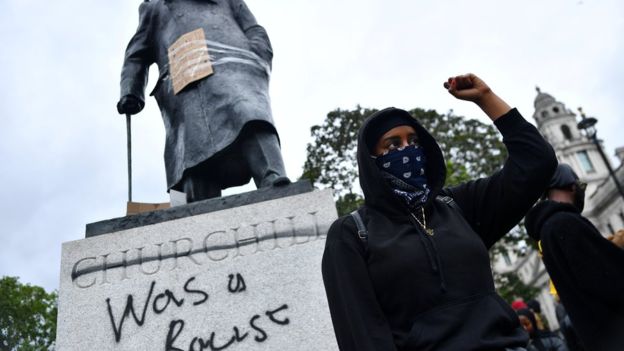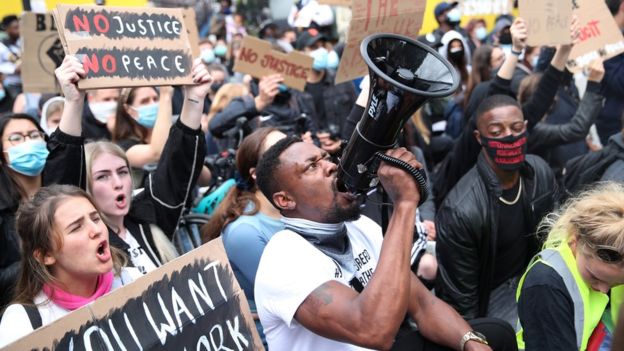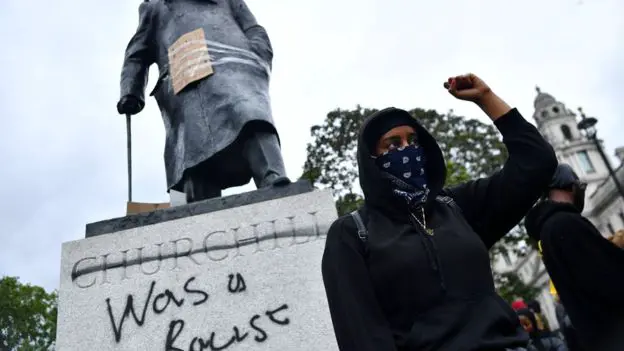
The Parliament Square statue of Sir Winston Churchill was sprayed with graffiti. /Reuters
Editor's note: Mark Hoskin is a doctorate researcher at the School of African and Oriental Studies in the University of London. The article reflects the author's opinions, and not necessarily the views of CGTN.
Momentous events this weekend in Britain remind us that the country was a center of a global economy built on slavery, the trafficking of illicit drugs, and mass inhumanity that many Western countries participated in. UK ministers, including Prime Minister Boris Johnson, who referred to acts of "thuggery" on social media, have condemned violence at a Black Lives Matter march in London, and the toppling of a statue in Bristol. These events are part of the continuing protests in Western nations over the killing of George Floyd in America.
The statue of 17-18th century African slave trader and ex-MP Edward Colston, that has been the target of several initiatives to have it removed over the past few years, was ceremoniously dumped in the dock waters, with a symbolic rope tied around its neck. Bristol Mayor Marvin Rees told the BBC: "Circumstances came to a head at this particular moment in time, and people felt the need to take the statue down."
Sir Keir Starmer, the Labor Leader, told LBC Radio that "it's completely wrong to pull down a statue like that. But that statue should have been taken down a long, long time ago." Neither politician reverted to name-calling or any form of labeling, speaking in cautious terms that accepted people have differing points of view.
Many of the people engaging in protest and scenes of violence, including the injury of eight officers outside the U.S. Embassy in London, appear to be young adults. The likelihood is none of them were born when U.S. President Ronald Reagan famously said in West Berlin "Mr Gorbachev, tear down this wall" on June 12, 1987. After the wall was torn down on November 9, 1989, many Soviet icons were also toppled, acts that defined the passing of an era. They included statues of Joseph Stalin, the former Soviet Union leader during World War II.

Protesters chant "Black Lives Matter" and "no justice, no peace". /Reuters
Today, many Russians remember the sacrifice of millions in that war, memories that connect that sacrifice to Stalin as the political leader that oversaw the Soviet Union's victory. There was no complaint of thuggery or that it should be done democratically from Western leaders, there was only satisfaction at the symbolic end of a wartime ally who became a Cold War foe.
In 2003, the Second Gulf War began, an action now held to have a wrongful basis due to the faulty U.S. and UK claims of Weapons of Mass Destruction. In Firdos Square, the overbearing statue of Saddam Hussein was toppled, a symbol of his downfall that was beamed around the world. There were no complaints after this event, it was, just as the topping of Stalin's statues were, held up as a right of the people to express themselves. The younger people of today who toppled Edward Colston's statue may barely remember it. It is more likely that this event, along with the fall of the Berlin Wall, are historical footnotes that are learned in school lessons..
While it can be argued that as public property, which statues generally are, wanton destruction should not be their fate. However, the historical reality is that statues are toppled both to make a statement that cannot be ignored, and later viewed historically as a mark of societal change. Western leaders have generally accepted that as fact, and even encouraged such destructive activities as an act of violence within a larger political moment overseas.
In Britain today, there has been over a year of publicity and direct political encouragement concerning events in Hong Kong. Footage of protests that descended into full scale riots has seen the use of Molotov cocktails, slingshots, and other deadly weapons. While no rioter has been killed to date, a remarkable statistic so far, the property and infrastructure damage have resulted in economic and social issues that will outlive the effects of the current pandemic.
The response to these acts from some Western leaders has been supportive, leading to the creation of laws in the U.S., and calls for a resurgence of what can only be considered as colonialism, a direct cause of continuation and violent escalation as those participating become immune to the harm they cause others. The society in which we live has sprouted many of the same tendencies among a generation that has grown up with the understanding that such violent acts are lauded and monetized at home.
In a historical context, protest, rioting, and statue destruction has been encouraged and publicly supported by U.S. and UK politicians when it occurs overseas. The same politicians should therefore not be surprised these activities can also occur in the current domestic setting, after the abhorrent death of George Floyd at the hands of those supposed to protect resonated with so many people around the world. The creation of this history is not only marked by violence in protest, it is the call of a generation that sees symbols of a colonial past as abhorrent.
(If you want to contribute and have specific expertise, please contact us at [email protected].)
 简体中文
简体中文





